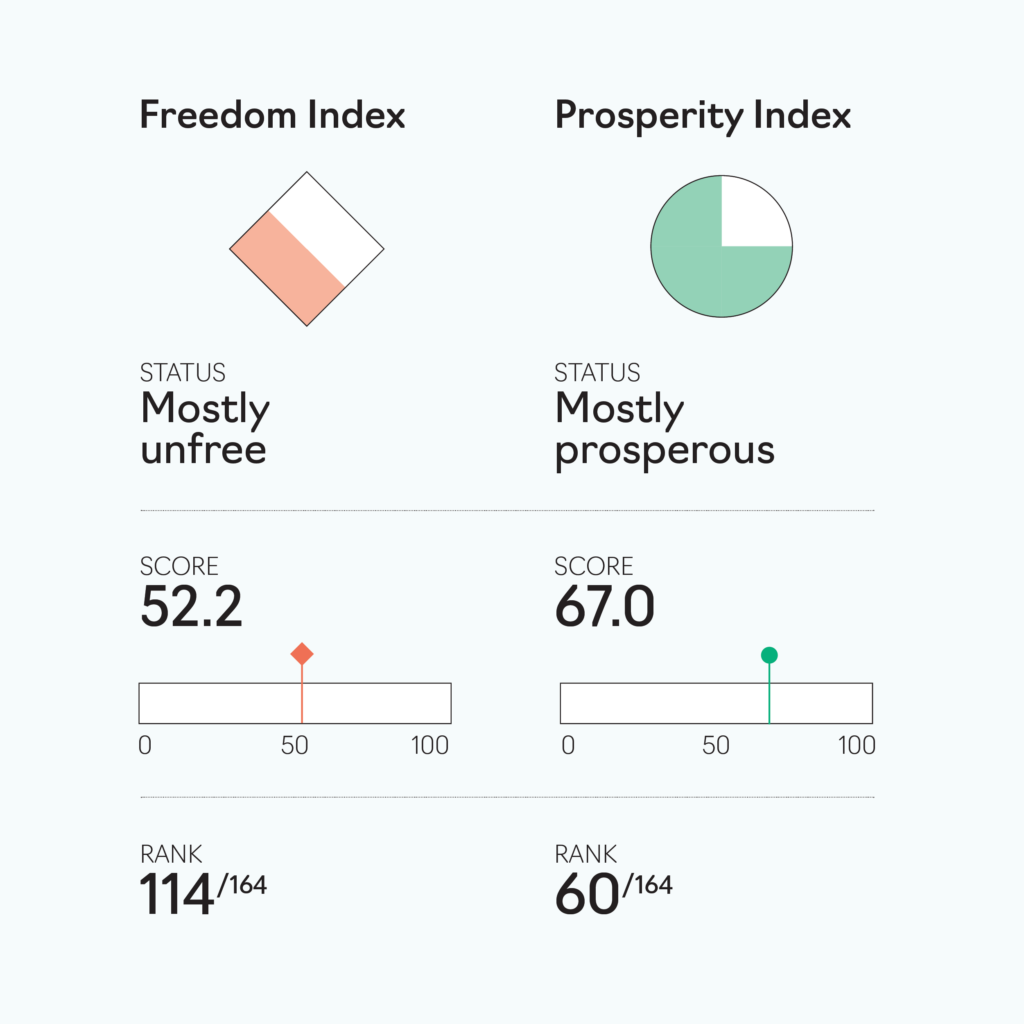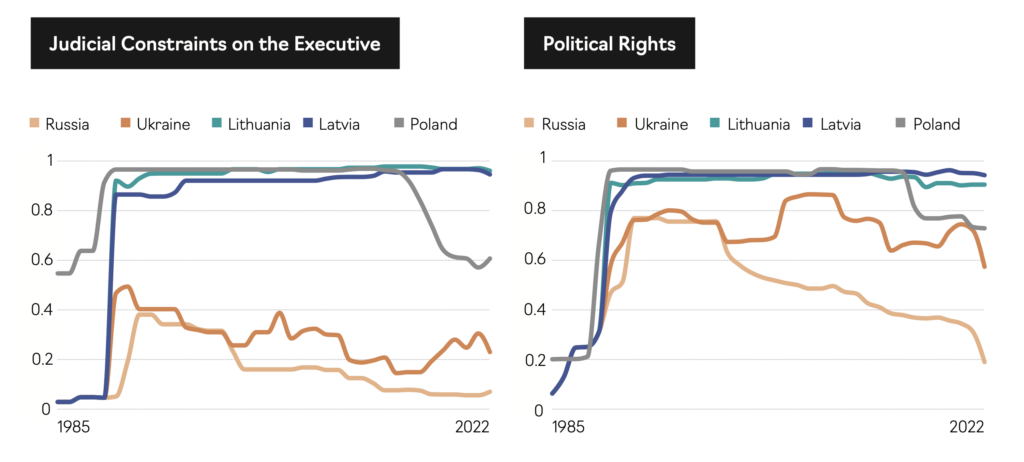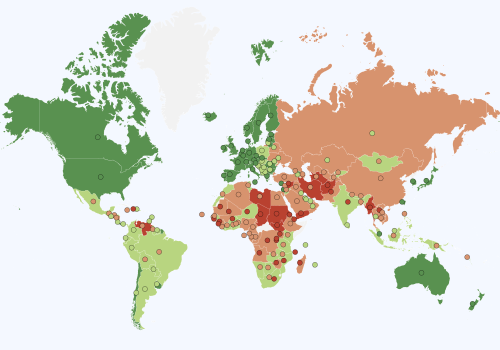Ukraine’s recovery hinges on allied support
Table of contents

Evolution of freedom
The flat trend of the Freedom Index between 1995 and 2004 mainly reflects the presidency of Leonid Kuchma, a “red” premier with a Soviet mentality who was not particularly interested in building democracy. The Orange Revolution and the new presidency of Viktor Yushchenko, which began in 2005, brought significant change towards democracy, political freedom, and economic liberalization. These reforms are clearly picked up by the political freedom subindex. In particular, the indicator concerning legislative constraints on the executive seems to be reflecting the substantial changes in the Constitution introduced during this period, that reduced the power of the president in favor of the parliament.
The Freedom Index, and especially the political freedom subindex, starts declining in 2010 with Viktor Yanukovych as president. This period represents a clear backsliding in terms of democratic reform, which intensified in 2013–14 when the government tightened the screws on civil society and the economy. The subsequent recovery is attributable to the Revolution of Dignity (also known as the Euromaidan), with several positive changes towards liberalization in political and economic terms. For example, the press became much freer and more independent. Nowadays, in the midst of the Russian invasion, it is hard to measure the degree of freedom in Ukraine because martial law imposes many restrictions.
The economic freedom subindex reflects the ups and downs of Ukraine’s economy in the last three decades. Generally, the level of investment freedom in Ukraine is significantly lower than in other countries of the former Soviet bloc that introduced much more radical reforms upon independence (e.g., the Baltic states). This low level is consistent with other measures of openness; for example, the Chinn-Ito index of restrictions on capital accounts paints a similar picture. Although Ukraine tried to open up, various steps toward liberalization were rolled back when the country faced economic and security crises. For instance, the government introduced stricter capital controls during the global financial crisis of 2008–09 to tame the panic. At the same time, Ukraine’s external trade has been a success story. Not only did Ukraine become much more integrated in global markets, but it was also able to redirect trade away from Russia after Russia annexed Crimea and occupied parts of the Donbas in 2014. Ukraine generally has few barriers to cross-border flows of goods and services. These very divergent trajectories for capital openness versus trade openness are also shown in the components of the economic freedom subindex.
The lack of improvement in legal freedom from 1995 to 2014 could be explained by the fact that, unlike other Eastern European countries, Ukraine did not institute a radical reform of its legal architecture on independence. Instead, there were small incremental changes from the Soviet system. For example, the labor code was written in the 1970s, and only sporadic, piecemeal changes have been made since then to make it a little more modern. As a result, the Ukrainian legal system is fraught with contradictions and inconsistencies. The history of the Constitution illustrates the complexity and ever-changing nature of the legal system. After being adopted in 1996 (which is a slow start relative to peer countries), the Constitution was amended in 2004 to limit presidential powers. President Yanukovych cancelled these amendments in 2010 before they were reinstated after the Revolution of Dignity in 2013–14. The big drop in legal freedom in 2014 is mainly driven by a plummeting security component, which reflects Russia’s annexation of Crimea and partial occupation of the Donbas.
These dynamics are consistent with Figure 1 below, which shows the evolution of two indexes produced by the V-Dem Project—on judicial constraints on the executive and on political rights—since 1985. Upon the fall of the Berlin Wall in 1989, the path toward free institutions is markedly different for Ukraine than it is for other nations in the orbit of the USSR. While Latvia, Lithuania, and Poland quickly reached very high scores on both indexes, Ukraine followed the much weaker Russian reform path until the year 2000. With the turn of the century, Ukraine departs from the declining trend of Russia, but it still lags behind its more successful neighbors.
Figure 1. Institutional reform in selected countries (1985–2022)

Source: V-Dem Dataset’s Judicial Constraints on the Executive Index (left), and Political Civil Rights Index (right).
One can see how the low level of legal and economic freedom generates inefficiencies and deters economic development in Ukraine by looking at the sectors and firms that are thriving. For example, the IT sector in Ukraine is very competitive and successful in the global market because it does not require a lot of physical capital. Instead, the IT sector is based on human capital which is much harder to expropriate than physical capital. This means that the sector does not need to rely on the judicial system as much as other sectors. Similarly, the agricultural sector, another highly successful part of the Ukrainian economy, is very decentralized, which creates competition and limits the power of oligarchs or other vested interests.
From freedom to prosperity
The evolution of the income component for Ukraine is very positive from 1995 up until the global financial crisis of 2008. During this period, the country experienced a fast recovery from the initial shock of transitioning from the Soviet system. A giant economic boom was fueled by easy credit and inflows of foreign direct investment. This economic expansion was halted by the global financial crisis. The banking sector was hit particularly hard and accumulated a large share of nonperforming loans. With no political will to reform the financial sector, banks became “zombie” institutions, weighing down the broader economy. Weakened by the financial crisis, the economy went through another massive upheaval after the Russian aggression of 2014. Although Ukraine implemented many reforms since 2014, and was thus more prepared to withstand the COVID-19 shock, security concerns weighed heavily on the country, depressing investment and consumption. In short, since 2008 the country has not been an attractive place to invest and produce, leading to the stagnant income we can see over the last fifteen years. The full-scale Russian invasion of Ukraine in 2022 obviously made the economic landscape even more difficult.
Data on inequality are always difficult to analyze, especially so for Ukraine because of its large informal sector. Although this factor distorts the level of inequality, examining changes in this component can still be a revealing exercise. For example, the distribution of income becomes more equal during the 1990s because incomes contracted deeply for nearly everyone due to the collapse of the previous system, hyperinflation, and so on. Inequality rose in the early 2000s as the economic recovery benefited some people more than others. The so-called oligarchs were clear winners, and this was the period in which they consolidated their economic and political power. From 2008 on, it is very hard to unpick the true evolution of inequality because of the deep crises the country faced: The global financial crisis of 2008–09 affected the population highly unevenly. The Russian annexation of Crimea and partial occupation of the Donbas displaced millions of people. The COVID-19 pandemic had heterogeneous effects on the economy and on different groups within the population. And then the fog of the current war makes any estimates of inequality tentative at best.
The very clear negative evolution of the minority rights component of the Prosperity Index, which measures religious freedom, is surprising. There is little indication that any ethnic or religious group is persecuted in Ukraine. Perhaps this dynamic reflects the fact that Ukraine was trying to limit the influence of a Russian “fifth column.” For example, Ukraine established a Ukrainian orthodox church, independent of Moscow, and has encouraged communities to switch from the Moscow patriarch to the Kyiv metropolitan. This may create formal signs of reduced rights of minorities but there have been hardly any objective impediments to citizens practicing their faith, or exercising their religious freedom. Indeed, religious and other minorities are well represented at the highest levels in Ukraine: President Zelenskyy is himself a Jew and Minister of Defense Umerov is a Crimean Tatar.
Regarding education, the divergence from the European average that seems to have started in 2005–06 does not have an obvious explanation. The capacity of universities in Ukraine exceeds the size of the graduating classes from high school. Therefore, anyone who wants to go to college can do so without problems. Surprisingly, this trend was not reversed by the economic crisis of 2008–10, because people delay entering the labor market in recessions and pursue further education in order to wait for better employment prospects. The trend away from the European average is perhaps partly explained by the fact that many more Ukrainians study abroad (the number more than tripled from 2007 to 2019) and it is possible that their educational attainment is not being properly recorded. Unfortunately, Ukraine has not had a census since 2001 and thus reliable data on socioeconomic outcomes are scarce.
The improvement in the environmental indicator in the 2004–14 period is most likely capturing the fact that Soviet-era heavy industry was clearly declining, and losing ground relative to other sectors of the economy like services. For example, the improvement in the indicator begins in 2007–08. This timing is consistent with the fact that the metals industry, a heavy polluter, was decimated during the global financial crisis (production declined by approximately 60 percent) and even after recovery, production stood at roughly 60 percent of its pre-crisis level. However, some of the improvement in the environment indicator is in line with a deliberate, but modest government policy to tighten environmental standards.
The initial level of the health indicator was very low. Heavy pollution, high consumption of alcohol, widespread smoking, and the low quality of healthcare services are clear contributors. From its low base, Ukraine could and did improve health outcomes through effective policies, a stronger economy, and a changing culture. For example, successive governments in Ukraine have consistently increased taxes on tobacco and alcohol, and higher incomes have helped to improve diet and access to food. The public healthcare system was largely unreformed until 2014, but after the Revolution of Dignity, the government pushed different measures to make the healthcare system more patient-centric, improve access, and reduce corruption. The system remains largely government run but there has been some entry of private providers in large cities.
The future ahead
The future of Ukraine will be shaped by its accession to the European Union (EU) and NATO. Joining the EU requires a lot of convergence—and hence upgrades—in terms of the legal structures, economic conditions, and environmental/health standards. The experience of Poland and other former communist countries suggests that Ukraine will see radical improvements after accession, in labor productivity, market access, infrastructure and other key metrics of economic progress. Joining NATO will be critical for addressing security concerns. To put it bluntly, if Ukraine were to join NATO, Russia would not be able to attack it again. NATO can guarantee peace and thus make Ukraine an investable country and allow refugees to return.
Obviously, with the ongoing war, any outlook is highly uncertain. However, one should flag two challenges for Ukraine.
First, there is a widespread perception that the Ukrainian judicial system does not adequately protect private property or the individual rights of citizens, and does not act as an effective check on executive power and corruption. This is a fundamental challenge that needs to be addressed in the next five to ten years if the country is to become a success story.
Second, the war will leave many scars on the country. These will be destroyed factories and homes (although rebuilding these could allow the country to modernize its infrastructure and productive capacity), and also huge swaths of land will have to be de-mined. Millions of Ukrainians are displaced; many (likely more than a million) will be veterans who will need reintegration into civilian lives, and hundreds of thousands will need medical attention (lost limbs, post-traumatic stress, etc.). Furthermore, there will be a whole generation of children who have not received a proper education through the years of COVID-19 and war. The losses of human capital are enormous and hard to reverse. Ukraine will need the help of its allies and deliberate policies to recover from these adversities.
Yuriy Gorodnichenko is Quantedge Presidential Professor at the Department of Economics, University of California – Berkeley. He received his B.A. and MA at EERC/Kyiv-Mohyla Academy (Kyiv, Ukraine) and his Ph.D. at the University of Michigan. He is broadly interested in macroeconomics and issues related to transition economies (especially, labour markets and firm performance). Gorodnichenko serves on many editorial boards, including Journal of Monetary Economics and VoxUkraine. He is also affiliated with NBER and IZA.
EXPLORE THE DATA
Image: A woman walks in front of the Soviet Army Monument, painted in colours of the Ukrainian flag in downtown Sofia, during an artistic demonstration against the Russian invasion in Ukraine, in Sofia, Bulgaria, February 27, 2022. REUTERS/Spasiyana Sergieva
